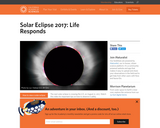
In this activity, students make observations of a living thing and ask relevant questions about its characteristics or behavior.
- Subject:
- Science
- Material Type:
- Lesson Plan
- Provider:
- California Academy of Sciences
- Date Added:
- 01/31/2017

In this activity, students make observations of a living thing and ask relevant questions about its characteristics or behavior.

This video weighs the benefits and drawbacks of nuclear energy. A set of discussion questions and post-viewing activities are provided.

In this lesson, students will obtain, evaluate, and critically discuss information about the highly-debated topic of nuclear energy. As citizens of the fictitious town of Solutionville, students must decide whether or not they support building a nuclear power plant in the community to replace coal as their source of electricity.

In this activity, students will use the skill of scientific sketching to better observe and document the natural world. This simple-to-lead activity gets them closer to constructing explanations for the variation of traits seen within a species.

In this lesson, students learn what organisms are affected by ocean acidification. They will then take on the role of one of the stakeholders affected by ocean acidification and create a poster to address their issue(s). They will also participate in a mock conference to address the effects of ocean acidification and discuss solutions to reduce ocean acidification.

In this lesson, students will be challenged with an optimization problem. The fictitious town of Solutionville has decided to replace coal, their current source for electricity, with more sustainable energy sources. In designing Solutionville’s sustainable energy future, students must consider not only the geographic constraints of various renewable energy options–wind energy, hydroelectric power, geothermal energy, and solar energy–but they must also meet specific energy production requirements and budgetary constraints.

In this lesson, students trace patterns of agricultural expansion through space and time, especially as they relate to climate and geography. How are patterns of human settlement and human population growth linked? Do you see evidence for how agriculture spread and retreated from different places based on historical events?

In this lesson, students will watch a visualization of empirical scientific data to explore seasonal changes in primary productivity on the earth. They will then formulate and research their own scientific questions about primary productivity on the earth and present their research in a classroom scientific poster session.

This video discusses how plastic debris is impacting our oceans. A set of discussion questions and post-viewing activities are provided.

In this lesson, students identify the common characteristics of primates that allow them to survive in their environments. Students will also explore how changes in the environment can affect the survival rate of certain organisms in an ecosystem and come up with at least one action item to help protect primates in the natural world.

In this lesson, students will practice rapid ideation—an important step in design thinking—by brainstorming solutions to issues surrounding global water use and conservation.

This video explores what some communities are doing to put water back into the ground to recharge aquifers. A set of discussion questions and post-viewing activities are provided.

This video explores some of the clean and green technologies that exist for generating renewable energy. A set of discussion questions and post-viewing activities are provided.

In this activity, students will learn the parts of algae, compare them to land plants, and rotate through exploration stations to investigate seaweed close up with their different senses.

In this lesson, students will observe the effects of a simulated oil spill on land, water, and wildlife. In groups, students will then test different materials and tools used to clean up oil spills and evaluate them for their effectiveness.

In this citizen science project, students observe and document the behaviors of animals before, during, and after totality of the eclipse.

This video discusses invasive species and nutrient pollution as two major issues threatening the health of the oceans. A set of discussion questions and post-viewing activities are provided.

In this lesson, students will investigate leaves up close to look for the structures responsible for gas exchange.

In this activity, students use a model for how fishing affects marine life populations and then construct explanations for one of the reasons why fish populations are declining. They will then work to design solutions for ways of making fisheries more sustainable for the animals and the people who depend on them.

In this lesson, students will work together to map out the strengths and limitations of potential solutions to some important global food system issues. This lesson is part of a larger unit whereby students practice different steps in design thinking within the context of issues surrounding our global food system. In this exercise, students will practice comparing potential solutions in order to prepare for the culminating activity of the unit: a design thinking challenge.